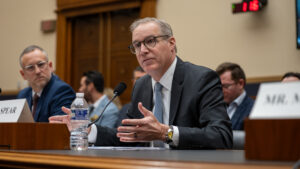WASHINGTON — U.S. inflation surged to a new four-decade high in June because of rising prices for fuel, food and rent, squeezing household budgets and pressuring the Federal Reserve to raise interest rates aggressively — trends that raise the risk of a recession.
The government’s consumer price index soared 9.1% over the past year, the biggest yearly increase since 1981, with nearly half of the increase due to higher energy costs.
The rising inflation has certainly not spared the trucking industry.
“Right now, motor carriers are getting slammed by nightmarish surges in the price of diesel,” states a recent blog posting from the American Trucking Associations (ATA). “It’s especially hard on smaller fleets, which don’t operate at a scale to negotiate rates down or lock prices into a contract. These small businesses account for 97% of trucking companies in the U.S., running 20 trucks or fewer.”
Even though diesel prices are inching down, the damage has already been done for many in the industry.
Truck driver Lee Sanders told The Trucker that he started a two-truck dry van owner-operator company two years ago but has had to shut down due to the current economic circumstances affecting the trucking industry.
“I just hedged my bet for too much and lost,” Sanders said. “I gave it a shot, and that’s all you can do. I am probably going to go try to get a company job to make ends meet right now. Who knows, I might give it a go on my own again one day.”
Additionally, as Freightwaves reported recently, there are simply too many truck drivers for the amount of work available, meaning lower and lower pay.
During the last major trucking recession in 2019, hundreds of trucking companies declared bankruptcy, unable to cover the costs of running a trucking company with deflating rates.
Fleets as tiny as one driver comprise the bulk of these shuttering trucking companies, according to Freightwaves.
Avery Vise, who is the vice president of trucking at FTR, said many of these drivers will join larger fleets rather than get flushed out of the market completely.
Chris Tucker, owner of Full Coverage Freight, predicted in a June 10 Facebook post on the Rate Per Miles Masters group, which hosts about 33,000 trucking professionals, that the many truck drivers who flooded the industry amid unprecedented truck volumes would have to shut down their operations.
Ill-prepared brokers would also face the same doom, he wrote.
“I don’t think there’s enough freight out there to justify their existence anymore,” Tucker told FreightWaves.
DIESEL’S SURGE
When the price of diesel goes up, the cost of everything else follows. Inflation can’t be controlled without some relief in price of diesel, because all U.S. supply chains begin and end with our nation’s truck fleet.
“Fortunately, this is a solvable problem,” the ATA blog post stated.
- ATA officials say they are calling on officials in Washington to take the following actions:
- Utilize the oil and natural gas found in the Gulf of Mexico by expediting lease sales and permits for offshore energy production.
- Fast-track onshore oil & natural gas permitting to spur expanded production.
- Announce realistic leasing and development opportunities for onshore & offshore energy.
- Expedite permitting for pipelines and other energy infrastructure.
- Encourage expedited carbon capture & sequestration rulemaking to ensure that America remains a world-leader in emissions reduction.
OVERALL ECONOMIC IMPACT
Accelerating inflation is a vexing problem for the Federal Reserve, too. The Fed is already engaged in the fastest series of interest rate hikes in three decades, which it hopes will cool inflation by tamping down borrowing and spending by consumers and businesses.
The U.S. economy shrank in the first three months of the year, and many analysts believe the trend continued in the second quarter.
“The Fed’s rate hikes are doing what they are supposed to do, which is kill off demand,” said Megan Greene, global chief economist at the Kroll Institute. “The trick is if they kill off too much and we get a recession.”
The likelihood of larger rate hikes this year pushed stock indexes lower in afternoon trading. The central bank is expected to raise its key short-term rate later this month by a hefty three-quarters of a point, as it did last month.
As consumers’ confidence in the economy declines, so have President Joe Biden’s approval ratings, posing a major political threat to Democrats in the November congressional elections. Forty percent of adults said in a June AP-NORC poll that they thought tackling inflation should be a top government priority this year, up from just 14% who said so in December.
After years of low prices, a swift rebound from the 2020 pandemic recession — combined with supply-chain snags — ignited inflation.
Consumers unleashed a wave of pent-up spending, spurred by vast federal aid, ultra-low borrowing costs and savings they had built up while hunkering down. As home-bound Americans spent heavily on furniture, appliances and exercise equipment, factories and shipping companies struggled to keep up and prices for goods soared. Russia’s war against Ukraine further magnified energy and food prices.
In recent months, as COVID fears have receded, consumer spending has gradually shifted away from goods and toward services. Yet rather than pulling down inflation by reducing goods prices, the cost of furniture, cars, and other items has kept rising, while restaurant costs, rents and other services are also getting more expensive.
The year-over-year leap in consumer prices last month followed an 8.6% annual jump in May. From May to June, prices rose 1.3%, following a 1% increase from April to May.
Some economists believe inflation might be reaching a short-term peak. Gas prices, for example, have fallen from the eye-watering $5 a gallon reached in mid-June to an average of $4.63 nationwide Wednesday — still far higher than a year ago.
Shipping costs and commodity prices have also begun to fall, and pay increases have slowed. Surveys show that Americans’ expectations for inflation over the long run have eased — a trend that often points to more moderate price increases over time.
“While today’s headline inflation reading is unacceptably high, it is also out-of-date,” President Biden said Wednesday. “All major economies are battling this COVID-related challenge.”
The latest disappointing data on inflation came out at the outset of Biden’s trip to the Middle East, where he will meet with officials from Saudi Arabia to discuss oil prices, among other subjects.
Republican members of Congress have blamed the higher prices on Biden’s economic policies, specifically his $1.9 trillion financial support package approved in March.
There have been signs that inflation was slowing before — last summer, and in April of this year — only for it to surge again in subsequent months.
“There may be some relief in the July numbers — commodity prices have come off the boil, at least — but we are a very, very long way from inflation normalizing, and there is no tangible sign of downward momentum,” said Eric Winograd, an economist at asset manager at Alliance Bernstein.
For now, the relentless pace of price increases is frustrating many Americans.
Delores Bledsoe, a truck driver hauling freight from Carlisle, Pennsylvania to Wisconsin on Wednesday, said her fuel costs have tripled. “It’s making me want to get out of the truck and go drive an Uber,” said Bledsoe, who lives in Houston. “It’s depressing.”
Some people are placing blame on companies for using inflation as a cover to raise prices beyond the amount they need to cover their own higher costs.
“I feel the inflation pain every day,” Susana Hazard said this week outside a grocery store in New York City. “Every day, everything is going up and up, more than inflation — they’re price-adjusting. Because even if inflation doesn’t happen, they’ve raised the prices.”
Most economists say corporate price gouging is, at most, one of many causes of runaway inflation and not the primary one.
Housing and rental costs are rising steadily as solid job gains encourage more Americans to move out on their own. Rents have risen 5.8% compared with a year ago, the most since 1986. And the cost of decorating homes is still increasing at a rapid pace — furniture prices are up 13% from a year ago — even as retailers such as Walmart and Target experience rising inventories, which should help lower prices.
The biggest shock has been energy prices, which soared 7.5% just from May to June. Gas prices have skyrocketed nearly 60% compared with a year ago.
Excluding the volatile food and energy categories, so-called core prices rose 0.7% from May to June, the biggest such spike in a year. Core prices jumped 5.9% from a year ago.
Inflation is surging well beyond the United States, with 71 million people pushed into poverty in the three months after Russia invaded Ukraine, the U.N. Development Program said last week.
The war’s economic damage has been especially severe in Europe, with its reliance on Russian oil and natural gas squeezing businesses and consumers with sharply higher bills for utilities, groceries, gasoline and more. Inflation reached decades-high levels of 8.6% last month in the 19 countries that use the euro currency and 9.1% in the United Kingdom in May.
The Associated Press contributed to this report.
The Trucker News Staff produces engaging content for not only TheTrucker.com, but also The Trucker Newspaper, which has been serving the trucking industry for more than 30 years. With a focus on drivers, the Trucker News Staff aims to provide relevant, objective content pertaining to the trucking segment of the transportation industry. The Trucker News Staff is based in Little Rock, Arkansas.
















Providing a holistic view of surging U.S. inflation, reaching a 40-year peak. Shedding light on trucking industry challenges due to soaring fuel costs and driver oversupply. Addressing government actions, Federal Reserve’s stance, broader economic ripples, political repercussions, and global inflation implications. Introducing “TaxZerone,” an IRS-approved e-file service aiding seamless, secure filing of various IRS forms for businesses and individuals. Visit: www.taxzerone.com